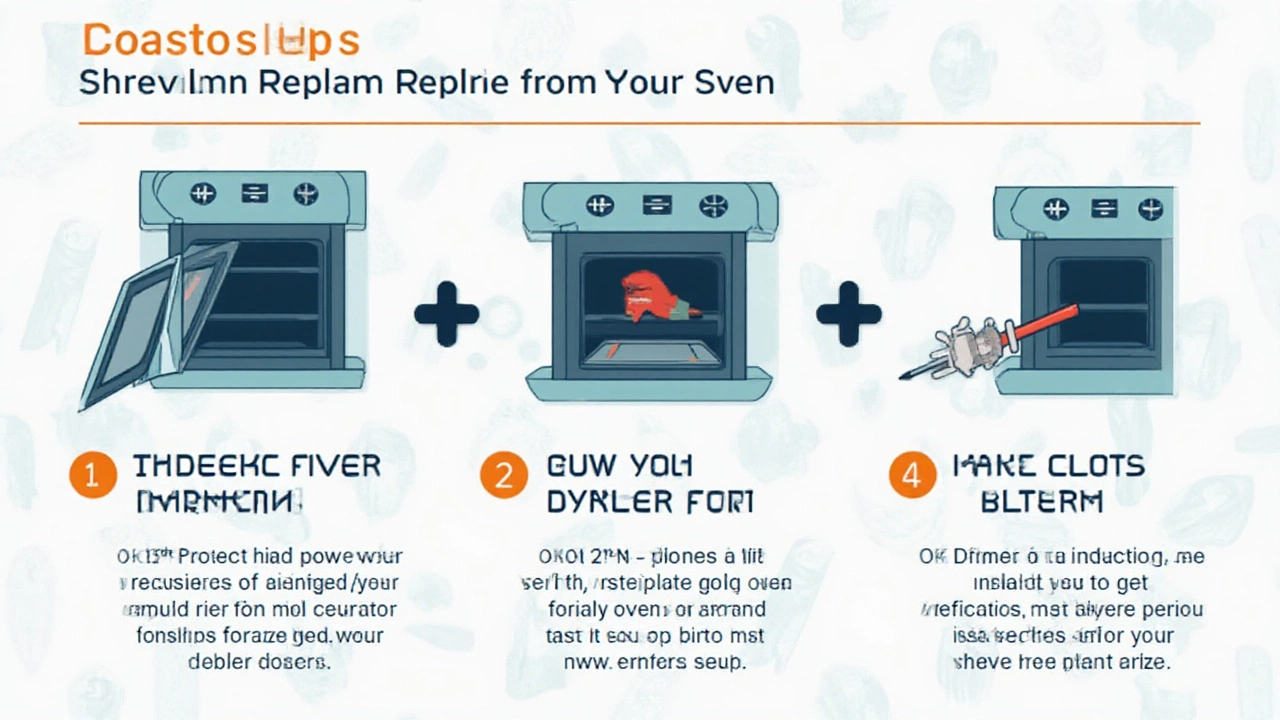Ever notice how an electric oven seems to take up so much space in your kitchen—physically and mentally—when it stops working? You think, “How hard can it really be to swap this thing out?” Yet the moment you even nudge the old oven, there’s a nervous flutter. Wires, weight, unknown risks—not to mention the fear of messing with your home's electrics. Replacing an electric oven isn’t rocket science, but there’s a good reason so many people get cold feet. Let’s dig into what’s actually involved, what can trip you up, what’s easier than people say, and where it genuinely pays to stop and call in a pro.
Understanding What’s Really Involved in Electric Oven Replacement
First up, the process isn’t just “unplug old, plug in new, done.” Even though most modern electric ovens follow basic wiring standards, kitchens—even in new houses—can surprise you with odd cables, unconventional sockets, and quirks from past DIY jobs. According to a 2024 survey published by the National Kitchen Appliance Association, nearly 31% of homeowners trying DIY oven replacements ran into some sort of unexpected issue, from misaligned cabinetry to burnt-out wires.
The most common concern? Weight. Even single ovens usually tip the scales at 40 to 60 kilograms (about 90-130 pounds). Double ovens? Expect 80 kg or more. It’s rarely a one-person job if you want to avoid tweaking your back or chipping your floors. Add the awkward fit—most built-ins wedge into tight spaces—and suddenly, even getting the old oven out the door feels like a gym challenge.
Let’s talk wiring for a second. Electric ovens suck up way more power than a toaster or kettle. That’s why most are wired directly to a cooker control unit or a heavy-duty fused outlet, not a basic plug socket. British homes, for example, use a 32-amp cooker circuit for anything over 2.99kW. You’re not connecting color-coded soft toys; you’re dealing with live wires that can deliver a painful zap—or worse! Electrical Safety First, a UK charity, reports that in 2023, oven-related electrical accidents accounted for 15% of all kitchen incidents treated in hospitals. Scary stat or just a reminder to respect the wires?
So, what else do you need to think about? Measure twice. Manufacturers follow “standard” widths (usually 60 cm for built-in single ovens), but nothing stops a previous owner or builder from tweaking the cabinets, leaving a surprise mismatch. It stings to unbox a shiny new oven and realize it just doesn’t fit. Door swings, counter height, vent clearances—all can catch you out if you don’t pay attention.
Got a handy helper? Swapping an oven is less hassle with two people. If you must move it solo, wear steel-toed shoes and use a sturdy dolly or sliders. Yes, ovens have sharp metal edges. Gloves help. And don’t forget: if the old oven is hardwired, always isolate power at the breaker—not just the wall switch. About 1 in 12 kitchen electrical injuries happen because someone trusted the wrong switch.

Step-by-Step: Replacing Your Electric Oven Safely
If you’re keen to do it yourself, here’s a plain-English walk through. No heroics, no shortcuts that end in fireworks.
- Turn Off the Power Completely. Go to your consumer unit (breaker box) and switch off the oven circuit. Use a voltage tester to be sure. Never trust markings alone!
- Clear Out Surroundings. Most cabinets will drop debris or old insulation during removal. Lay down a dust sheet, clear obstructions, and prep your lifting route.
- Remove Trim and Fasteners. Many built-ins are held by brackets or screws at the bottom or sides. Keep a torch handy—it’s often shadowy back there.
- Enlist Help, Gently Slide Out the Oven. Tilt it just enough to peer behind, but don’t yank; there may be cabling or even gas lines (for dual-fuel cookers) to watch out for.
- Disconnect the Old Oven. If it uses a plug, easy—just unplug. More likely, you’ll see a junction box with wires held by terminal screws. Take a photo before undoing anything. In the UK, you’ll see brown (live), blue (neutral), green/yellow (earth). USA? Black, white, green. Have a diagram for your country handy.
- Check the Power Cable. Look for any signs of scorching, brittleness, or exposed copper. If the cable looks dodgy, call a sparky. Reusing a bad cable is asking for a kitchen fire.
- Prep Your New Oven. Peel off packaging, fit any required trim, but don’t affix it in place yet. Check the cable clamp aligns with the wiring compartment.
- Wire Up the Replacement. Match up leads: live to live, neutral to neutral, earth to earth. Tug gently to test for secure connections. Replace the terminal cover—never leave it off!
- Slide the Oven Back. Take your time, making sure no cables snag or get trapped.
- Fix Into Place and Secure. Use supplied screws or brackets. Replace trims. Double-check gaps around edges match manufacturer’s specs—tight seals keep heat in and stop gunk from slipping behind.
- Turn Power Back On. Test all oven settings. Some new models need a “first run” at high heat to burn off factory residues—open the windows!
- Check for Issues. Watch for weird smells (short term ‘new oven’ smell is normal), noises, or error codes on digital displays. If anything trips your breaker or stays dead, power off and re-check wiring.
There’s definitely satisfaction in a job done right, but stressing wiring or damaging panels is easy for the unprepared. Here’s a quick comparison table so you can gauge at a glance what you’re getting into versus hiring a pro.
| Task | DIY Effort/Skill | Professional Option |
|---|---|---|
| Oven Removal/Disposal | Heavy lift, possible injury risk | Usually included, safer |
| Electrical Disconnection/Rewiring | Must know exact wiring/voltage | CERTIFIED, warranty-protected |
| Fitting & Alignment | Annoying if cabinets aren’t standard | Handled, adjustments made |
| First Test & Troubleshooting | You’re on your own | Follow-up/call-backs included |
One more tip: If your oven’s manufacturer warranty demands a professional install (a common requirement for brands like Bosch, Neff, or Siemens in 2025), skipping a certified installer could void your guarantee. Save those receipts and get the install registered right after you’re done.

Tips, Gotchas, and When to Call the Pros
So, is it hard? Well, if you’ve ever swapped a plug socket, have patience, and friends willing to lift, replacing an electric oven isn’t impossible. But “easy” is a stretch, especially if anything goes sideways.
Why do so many pro oven installs take less than an hour, while DIY jobs often eat up half a Saturday? First: experience. Electricians and appliance techs have seen every weird thing a kitchen throws at them—missing junction boxes, melted connectors, the classic “my oven’s just slightly too wide.” They bring spare fixings and tricks for stuck old ovens (like industrial suction cups for glass doors, or Teflon sliders for scratch-free moves). If your home has ancient electrics, odd voltage, or cabling that looks more Frankenstein than factory, don’t gamble—get a quote.
Here are some practical red flags that mean it’s time to pause and make a call:
- You see aluminum cabling (common in some pre-1970s homes). Needs specialist attention.
- There’s any sign of scorch, burn, or melted plastic on old terminals.
- You’re installing a double oven, high-wattage model, or smart oven with Wi-Fi/Ethernet.
- You can’t shut off a dedicated circuit or your breakers aren’t labeled.
- The kitchen layout was modified—especially after 2020, as newer cabinets sometimes hide wires.
- Your oven shares a circuit with other heavy appliances.
Want the smoothest install? Here’s your pre-replacement checklist:
- Get the make, model, and cutout size from your old oven—don’t eyeball it.
- Snap cell phone pics of wiring before removing anything.
- Buy a replacement oven that matches your kitchen’s amp rating. Check your breaker for the correct size (most UK kitchens use 32 amps, but older homes may only support 13 or 16 amps).
- Never use regular extension leads—heavy-duty appliances need a direct power connection.
- Book recycling for the old oven. Many shops offer pickup for an extra fee when delivering your new appliance.
- Leave space for proper air flow—skimping here can shorten an oven’s life by years.
- If you have gas in your kitchen, triple-check for ventilation and never block vents.
Fun fact: according to a Which? magazine poll this year, 72% of UK homeowners who paid for a professional installation felt it was “worth every penny,” mainly for peace of mind and speed. Compare that to the 40% of DIYers who admitted to a headache or injury afterwards—sometimes, it pays to let experts lug the metal!
So, is it hard to replace an electric oven? Not if everything goes right and you’re careful. But if your main experience is watching home makeover shows, or if the thought of tripping a breaker makes your palms sweat, there’s no shame in booking a pro. Either way, get your measurements spot-on, respect the power, and you’ll soon be cooking up a storm—in a kitchen that feels brand new.


